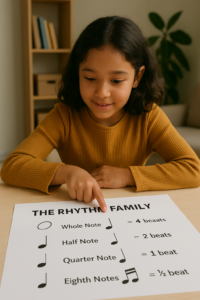If your child is new to music lessons, you’ve probably heard strange new words floating around your home:
Whole note. Half note. Quarter note. Rest.
Maybe you’ve even seen them scribbled in a practice notebook or music book.
To a young learner, rhythm might seem like the most confusing part of reading music. But here’s the secret: rhythm is actually where kids can have the most fun—and gain the most confidence.
At Lessons In Your Home, we believe that understanding rhythm is like learning the heartbeat of music. It’s what gives a song its groove, shape, and energy. Let’s break down why rhythm matters, how we teach it, and how your child can learn to feel the beat instead of fear it.
🥁 What Is Rhythm in Music?
In simple terms, rhythm is how music moves through time. It’s the combination of long and short sounds (or silences) that create the pulse or beat of a song.
Where pitch tells us what to play, rhythm tells us when to play it.
Just like your child learned to clap along to a favorite tune or chant a nursery rhyme with the right pauses, they already have some sense of rhythm—they just don’t know how to read it yet.
🎼 Understanding Note Values: The Rhythm Family
We teach rhythm using note values, which are symbols that represent how long a note should be held. The most common are:
- Whole Note – 4 beats (like holding a note and counting to 4)
- Half Note – 2 beats
- Quarter Note – 1 beat
- Eighth Notes – ½ beat each
- Rests – silence for the same durations
To make it kid-friendly, we use analogies like pizza slices:
- A whole note is a full pizza.
- A half note is two equal slices.
- A quarter note? Four pieces.
Who knew rhythm could be so tasty?
🕺 Rhythm Is a Feeling—Not Just a Fact
Some kids are natural movers. They’ll tap their pencil to a beat without realizing it. Others might need a little more help feeling where the beat lives.
That’s why our rhythm instruction includes:
- Clapping games
- Marching to music
- Echo patterns
- Body percussion
- Call-and-response activities
These activities are especially helpful for younger students (ages 5–12), who benefit from movement-based learning. It’s not just fun—it’s foundational.
📚 How Rhythm Helps With Music Reading
Understanding rhythm means your child won’t just play or sing the right notes—they’ll play them at the right time.
Rhythm builds:
- Fluency in sight-reading
- Timing in ensemble playing or singing
- Confidence when playing unfamiliar music
- The ability to stay on beat without relying on a teacher or recording
Even students who don’t initially “feel the beat” can learn to track rhythms visually and improve over time with practice and encouragement.
🎶 How We Teach Rhythm at Lessons In Your Home
Every music lesson we teach—whether it’s piano, voice, violin, drums, or guitar—includes rhythm instruction tailored to the student’s age and instrument.
We use rhythm cards, flash games, and short rhythm drills to make the concept stick. More importantly, we tie rhythm reading back to actual music your child is playing so they see the “why” behind what they’re learning.
And yes, we have students clap out rhythms before playing them. It might sound simple, but it’s one of the most effective tools in music education.
🎵 Ready to Get in Rhythm?
At Lessons In Your Home, we help students build confidence from their very first note—and beat. Whether your child is just beginning or ready to level up, our teachers bring engaging, personalized music lessons directly to your home (or screen).
🎼 Click here to schedule your first lesson.
Final Note:
So the next time your child says “What’s a whole note?” you can smile and say, “It’s the start of something musical.”
Because when kids understand rhythm, they understand music on a deeper level—and that’s when the magic begins.
